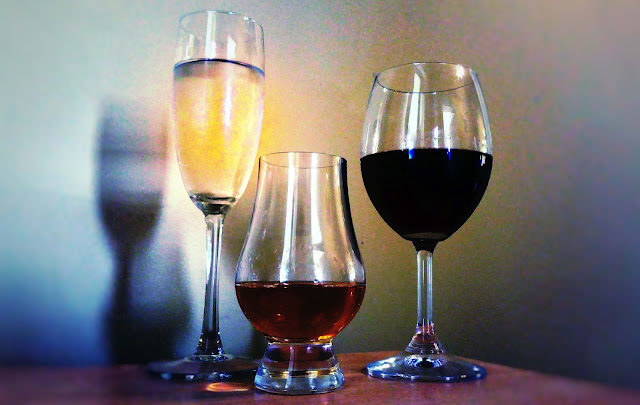Last month I attended the final two Destination Cellars whisky tasting events for the year.
Westland American Single Malts, Benromach Organic & Port Askaig 100 Proof
Our host for the first evening was Ian McKinlay, Managing Director of Alba Whisky. Ian began with a product that demonstrates some of the things I love about whisky, it has an interesting story and takes considerable effort to produce. When the Benromach Organic was launched in 2006, it was the first single malt whisky in the world to be certified organic. Gaining official organic certification is no easy task and in the case of Benromach, the Speyside distillery had to meet the requirements of the UK Soil Association. Certifying the ingredients and distilling process was relatively straight forward but when the auditors asked what happens after the spirit is distilled, they were not too pleased with the answer. As is normal practice, the spirit would be aged in used barrels, previously filled with either (non-organically certified) bourbon or sherry and constructed from oak of uncertified origin. To overcome this, Benromach had to use virgin (unused) American oak barrels, made of timber sourced from a free-growth forest in Missouri, USA. The result I am glad to say, was worth the effort. The Benromach Organic was a pale amber in colour, having been aged for five years in the custom-made sustainable virgin oak barrels. The nose was delightfully fresh and creamy with a hint of spice. It was smooth on the palate and tasted of sweet malt and pepper. The finish was medium length with fading spices. I really enjoyed this one.
 Next up was three American single malt whiskies from the Seattle-based Westland Distillery in the north-west corner of the USA. First up was the flagship Westland American Oak. I actually purchased a bottle of this whiskey, so I will save the notes for my full impressions. Next was the Westland Sherry Wood single malt, aged only 2.5 years in ex-sherry casks. All three Westland single malts are aged 2.5 years and would not be able to be called ‘Whisky’ if produced in Scotland, which has a minimum age requirement of 3 years. But many factors contribute to how quickly whisky matures such as barrel size, average temperature, humidity, fluctuations in barometric pressure and agitation. The Westland distillery can be found in Seattle, however, their bond store (where the barrels of whisky are taken to age) is located in the port city of Hoquiam, some 100km to the south-west. Hoquiam has lower average temperatures to Seattle, but less snowfall and twice the annual rain levels.
Next up was three American single malt whiskies from the Seattle-based Westland Distillery in the north-west corner of the USA. First up was the flagship Westland American Oak. I actually purchased a bottle of this whiskey, so I will save the notes for my full impressions. Next was the Westland Sherry Wood single malt, aged only 2.5 years in ex-sherry casks. All three Westland single malts are aged 2.5 years and would not be able to be called ‘Whisky’ if produced in Scotland, which has a minimum age requirement of 3 years. But many factors contribute to how quickly whisky matures such as barrel size, average temperature, humidity, fluctuations in barometric pressure and agitation. The Westland distillery can be found in Seattle, however, their bond store (where the barrels of whisky are taken to age) is located in the port city of Hoquiam, some 100km to the south-west. Hoquiam has lower average temperatures to Seattle, but less snowfall and twice the annual rain levels.
The Westland Sherry Wood single malt was dark gold in colour, belying its young age. The nose was subtle and hard for me to pick up much with the small sample I had. The palate was pleasant but unremarkable, once again hindered by only having a small sample; I would have liked to have spent some more time with this one. The finish was what really gave away the whisky’s age, it was very short, with slight spices on the tongue fading away quickly once swallowed.
Last from Westland was their peated expression. The Westland Peated single malt poured light golden straw in colour, much lighter than the Sherry Wood. The nose was only slightly smoky, which given its age suggest it was not peated a great deal. Westland uses a combination of five different malts and only one of those is peated for this expression with peat sourced from Inverness, Scotland. There are plans in place to use locally sourced peat in the future. On tasting it was difficult to identify any dominant flavours and like the Sherry Wood, the finish was quite short.
The final whisky for tasting on the night was the Port Askaig 100 Proof. Port Askaig is made with undisclosed Islay single malts and the 100 Proof expression is a NAS (no age statement) whisky, bottled at 57.1% ABV. The colour was extremely pale, close to clear in fact, meaning it was either very young and/or aged in very lightly charred or seasoned casks. The nose was smoky but there was something else there that smelt quite strange and I could not put my finger on it with the single sample. The whisky had a nice oily mouthfeel with a rush of spices. The finish lingered for a medium length and consisted of fading spice. A good, if not a little odd, peated single malt. Thanks to Ian McKinlay and his lovely wife Noreen for a very enjoyable evening.
Hyde Irish Whiskey
The last Destination Cellars tasting event for the year was hosted by Scott Farrow of Wonderland Drinks and covered five Irish whiskies from the Hyde portfolio. Hyde do not distill their own spirit (sourced from the Cooley Distillery) but rather operate as an Independent Bottler under their own label. Hyde age the spirit in first fill ex-bourbon casks before finishing the whiskey in either Oloroso sherry, dark Caribbean rum or Burgundy red wine casks in County Cork, Ireland. All Hyde whiskies are bottled at 46% ABV and are non-chill filtered.

The first whiskey of the evening was the Hyde No.5 The Aras Cask Irish Whiskey. This is a single grain Irish whiskey that has been matured for 6 years and finished in Burgundy red wine casks. It was light gold in colour and I found it to have a fresh, somewhat powdery nose that released sweet berry fruit notes with the addition of water. On tasting, it was light and sweet with flavours of grapes and berries. There was little to no spice or heat. The finish was short but sweet.
Next was the first of two dark Caribbean Rum finished whiskies. The Hyde No.4 President’s Cask Irish Whiskey is a single malt aged for 6 Years before being finished in ex-rum casks. Light gold in appearance, like the Hyde No.5, the whiskey smelt of sponge cake and banana bread, with notes of sweet raisins and sultanas. It tasted sweet with obvious rum flavours and a peppery spice building as it warmed in the mouth. The finish was medium length with fading spice concentrating on the end of the tongue.
The third whiskey for the evening was another single grain whiskey, this time, Hyde No.3 The Aras Cask Irish Whiskey which is aged for 6 years exclusively in ex-bourbon casks. The No.3 had a golden colour, slightly darker than the first two whiskies. The nose was subtle with hints of vanilla and nuts. The taste was anything but subtle however, with strong bourbon flavours, a result of using corn to make the spirit and maturing it in first fill ex-bourbon casks. As expected, it tasted sweet but with little spice. The addition of water cuts the spiciness ever further. The finish was medium length.
The fourth whiskey from Hyde was a special offering since it is now sold-out worldwide. The Hyde No.2 President’s Cask Irish Whiskey is finished in dark Caribbean rum casks like the No.4, but is aged for 10 years rather than six. This was my favourite Hyde whiskey on the night, purely because it was so different to any whisky I had tried before. Similar in colour to the No.3, the nose was of sweet tropical fruits, mostly pineapple. On tasting, it was lovely and smooth with hints of citrus and chocolate. The finish was medium to long in length with lingering spices tingling the tongue. Quite unique although almost impossible to find now.
The last Irish whiskey on offer was the Hyde No.1 President’s Cask Irish Whisky, aged for 10 years and finished in ex-Oloroso sherry casks. Golden in colour like the No.3 and No.2, the nose was subtle with hints of citrus, dried fruits and chocolate. On tasting is was smooth with some of the dried fruits coming through with some sweet caramel. The finish was medium to long length with an initial burst of spice before fading.
Heartwood Dare to be Different
The last whisky on the night was a special thank you from Todd Morrison of Destination Cellars. Having convinced a friend of mine to buy his first bottle of the now sold-out Heartwood Dare to be Different, Todd saved his only other bottle to share with us on the night. Bottled at a whopping 65.5% ABV, the Dare to be Different is not for the faint-hearted but for the seasoned whisky drinker, it is amazing! This was only the second time I had tasted this expression and I wish I had bought that other bottle for myself. Heartwood is a Tasmanian independent bottler famous for very high ABV cask strength and very limited release bottlings. Aged in Heartwood owner Tim Duckett’s Kingston bond store with a few extra days ‘cooking’ in the hot room, Dare to be Different stretched to only 330 bottles and sold out very quickly. This is a huge whisky, bottled from a single ex-Oloroso sherry cask filled with peated spirit from Tasmania’s iconic Lark Distillery. Dark amber in colour, the nose was rich and creamy with notes of dried fruits, raisins, sultanas and apricot. It has a sumptuous, thick and oily mouthfeel, flooded with spiced Christmas cake and dark chocolate flavours. The finish is long with slowly fading spices concentrated along the centre of the tongue. Alas, I only got a single pour of this beauty but I do have a full bottle of Heartwood We are Cousins at home.
Thanks to Ian, Scott and Todd for another pair of great whisky tasting evenings. If you are ever in Hobart, be sure to track down Destination Cellars and have a chat to Todd while admiring his impressive whisky selection on offer.




















